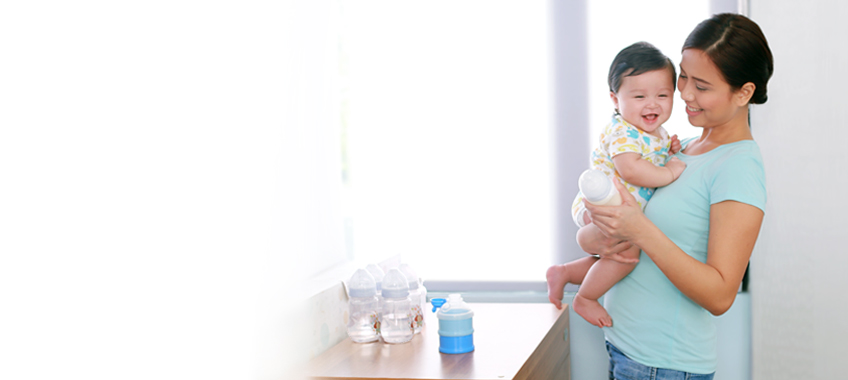From Nipple to Bottle: Transitioning from Breastfeeding to Bottle-feeding
Maybe your maternity leave is over or your baby is less interested in drinking milk ever since they started eating solid food – whatever the reason, transitioning your baby from breastfeeding to the bottle is not easy for any mother.
More than just meal time, breastfeeding is also a bonding moment for a mother and her baby. However, time will come when you have to transition your baby’s feeding habits from breastfeeding to the bottle and it won’t be easy.
If you feel that it’s time for your baby to transition, you can try some of the tips below:
- Check your baby’s readiness
The best sign to see if your baby is ready for bottle feeding is to let your baby decide.
At around 6 months, babies are usually well into eating solid food. This would be the best time to slowly ease them to the bottle since they are starting to get their nutrition elsewhere and will nurse less often.
If you’re not yet ready to introduce your baby to solid food, take a look at how to ease them into it here.
- Pick the perfect time
You cannot just change your baby’s feeding method from breastfeeding to bottle feeding abruptly. It has to be done subtly. Pick a time of the day when they do not really care about drinking milk to introduce the bottle. Don’t use the bottle during the morning’s first meal or the last meal at night. These are the times when the baby is most attached to breastfeeding. Try a time in the afternoon when the baby is playing or distracted so they won’t notice the bottle.
- Let someone else bottle-feed him
Babies tend to associate feeding with their mother’s breast. This is why it’s hard to convince them to drink from the bottle when the mother’s breasts are nearby. Ask for help from either your husband, or someone else with you, to feed them using the bottle. Be sure to stay in another room while they do so that baby does not see you. That way, your baby can keep their special bond of breastfeeding with you.
- Find the right bottle
Your baby will not be receptive to just any kind of feeding bottle. Finding the right bottle is a trial-and-error method. Find a nipple with holes that aren’t too big, as this can cause sputtering and gagging in your baby. On the other hand, don’t use bottles whose holes are too small or else your baby will have to work harder to get the milk out. Use a nipple that’s similar in shape to their pacifier. This also means having the same material their pacifier is made of. If their pacifier is made of latex, get a bottle nipple that’s also latex. Finally, try rubbing some of your breast milk on the nipples of the bottle so your baby will think that it’s still your nipple.
- Ease your pain
Some mothers stop regularly breastfeeding their children once they have successfully transitioned to bottle-feeding. In case you want to stop breastfeeding, your breasts may become painful because it takes a while for them to stop producing milk. You can try these steps to ease the pain:
- Chill your breasts. Applying a cold, damp cloth reduces the pain in them. Surprisingly, chilled cabbage leaves work best for this situation too as they take the shape of your breasts.
- Empty some milk. Pump some milk out of your breasts and refrigerate the breast milk to bottle-feed your baby at a later time. This removes some of the pain. Be careful not to empty them however as your brain might think that it needs to produce more.
- Leave your breasts alone. Be sure not to touch them too much. Massaging them sends a signal to your brain to produce more milk.
Transitioning from breastfeeding to bottle feeding is not something that can be done overnight. It’s a slow process that involves a lot of patience for the mother. This is why transitioning your baby takes a lot of effort and time from all members of the family. But once your baby has successfully transitioned, it will all be worth it.
If you want to talk to our EQ Support, click here.
Sources:
http://www.webmd.com/parenting/baby/features/weaningfrombreast
http://www.whattoexpect.com/firstyear/week47/weaning.aspx
http://www.babycenter.com/0_introducing-your-breastfed-baby-to-the-bottle-or-cup_473.bc

